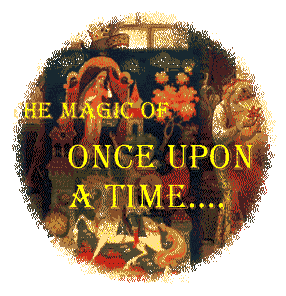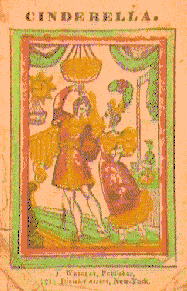
Narrative Logo - Click for Main Menu
Lecture 1 - Introduction and
Orientation: the Magic of Once Upon a Time
this Lecture:
August 22 - August 28
Orientation to Identification of
Folklore
How the Class will work
Your Final Research Project
Let us begin with a story. You might
recognize it!

Caption: Cover of 19th Century
copy of Cinderella. Cinderella and Prince, dancing.
There was once a large Indian village situated
on the border of a lake. (Nameskeek' oodun Kuspemku). At the end of this place was a lodge,
in which dwelt a being who was always invisible - a mighty hunter, whose
totem (teeomul) was
the Moose, Stupendous Deity of the spirit
world. He had a sister who attended to all his wants, and it was known that
any girl who could see him might marry him. Therefore there were indeed
few who did not make the trial, but it was long ere one succeeded.
And it passed in this wise. Towards evening, when the Invisible One was
supposed to be returning home, his sister would walk with any girls who
came down to the shore of the lake. She indeed could see her brother,
since to her he was always visible, and beholding him, she would say to her
companions, "Do you see my brother?"
They would mostly answer "Yes," though some said "Nay."
Then the sister would say, "Cogoowa' wiskoboosich?" --"Of what is his
shoulder strap made?" Or, as some tell the tale, she would inquire other
things such as, "What is his moose-runner's haul?" (the runners or
harness of his sled).
They would reply, "A strip of rawhide," or "A green switch," or
something of that kind. Then she, knowing they had not told the truth,
would reply quietly, "Very well, let us return to the wigwam."
When they entered the place, she would bid them not to take a certain
seat, for it was his. After they had helped to cook the supper, they would
wait with great curiosity to see him eat. Truly he gave proof that he was a
real person, for as he took off his moccasins they became visible, and his
sister hung them up; but beyond that they beheld nothing, not even when
they remained all night as many did.
There dwelt in the village an old man, a widower with three daughters.
The youngest of those was very small, weak, and often ill, which did not
prevent her sisters, especially the eldest, treating her with great cruelty.
The second daughter was kinder and sometimes took the part of the poor
abused little girl, but the other would burn her hands and face with hot
coals. Yes, her whole body was scarred with the marks made by torture, so
that people called her Oochigeaska (rough-skin or burnt-skin girl).
When her father, coming home, asked what it meant that the child was
so disfigured, her sister would promptly say that it was the fault of the girl
herself, for that having been forbidden to go near the fire, she had
disobeyed and fallen in.
Now it came to pass that it entered the heads of the two older sisters of
this poor girl that they would go and try their fortune at seeing the
Invisible One. So they clad themselves in their finest and strove to look
their fairest; and finding his sister at home went with her to take the
wonted walk down to the water. Then when He came, being asked if they
saw him, they said, "Certainly," and also replied to the question of the
shoulder strap or sled harness saying "A piece of rawhide." In saying
which they lied, like the rest, for they had seen nothing and got nothing for
their pains.
When their father returned home the next evening he brought with him
many of the pretty little shells from which weiopeskool (wampum) was
made, and they soon were engaged in napawejik (in stringing the shell
beads).
That day, poor little Oochigeaskw', the burnt-faced girl, who had always
run barefoot, got a pair of her father's old moccasins and put them into
water that they might become flexible to wear. And begging her sisters for
a few wampum shells, the eldest did but call her "a lying little pest", but
the other gave her a few.
Having no clothes beyond a few paltry rags, the poor creature went forth
and got herself from the woods a few sheets of birch bark (moskwe). She
made herself a dress of this, putting some figures on the bark by scraping
it. This dress she shaped like those worn of old. So she made a petticoat
and a loose gown, a cap, leggings, and handkerchief, and, having put on her
father's great old moccasins -- which came nearly up to her knees -- she
went forth to try her luck.
For even this little thing would see the Invisible One in the great wigwam
at the end of the village.
Truly her luck had a most inauspicious beginning, for there was one long
storm of ridicule and hisses, yells and hoots, from her own door to that
which she went to seek. Her sisters tried to shame her, and bade her stay
at home, but she would not obey; and all the idlers, seeing this strange
little creature in her odd array, cried "Shame !" But she went on, for she
was greatly resolved; it may be that some spirit had inspired her.
Now this poor small wretch in her mad attire, with her hair singed off and
her little face as full of burns and scars as there are holes in a sieve, was,
for all this, most kindly received by the sister of the Invisible One, for this
noble girl knew more than the mere outside of things as the world knows
them.
As the brown of the evening sky became black, she took her down to the
lake. And erelong the girls knew that He had come. Then the sister said
"Do you see him?"
The other replied with awe, "Truly I do -- and He is wonderful !"
"And what is his sled string?"
"It is," she replied "the Rainbow." And great fear was on her.
"But my sister," said the other, "what is his bow-string?"
"His bow-string is Ketak' soo wowcht" (the Spirits' road, the Milky
Way).
"Thou hast seen him," said the sister. And taking the girl home, she
bathed her, and as she washed, all the scars disappeared from her face
and body. Her hair grew again, it was very long and like a blackbird's
wing. Her eyes were like stars. In all the world was no such beauty. Then
from her treasure she gave her a wedding garment, and adorned her.
Under the comb, as she combed her, her hair grew. It was a great marvel
to behold.
Then, having done this, she bade her take the wife's seat in the wigwam
-- that by which her brother sat, the seat next to the door. When He
entered, terrible and beautiful, he smiled and said "Wajoolkoos ! -- so, we
are found out !"
"Alajulaa."
"Yes," was her reply. So she became his wife.
Folk and Fairy tales
are considerably more than the spoken equivalent of the printed short story.
The story that I have just related is
very like the version that appears in Neil Philip's The Cinderella Story (a book
that is, unfortunately, out of print). Philip collected twenty-four versions of the
Cinderella story - variations from China to Africa - in his book. He tells us,
however, that folklorists have collected an estimated 500 separate
iterations of the
Cinderella tale.
Of course, that figure probably doesn't include the several Disney products.
This version, which is called the
"Mi'kmaq Cinderella," and Philip's version, called "The Indian
Cinderella," are good introductions to the kind of persistence, and wonder,
that we find in folk tales from around the world and throughout time.
Some scholars, including Jack Zipes,
an author you will read in this class, claim that Cinderella-type stories have been
around since the end of the Ice Age. Others, such as Philip, trace the beginnings of
the Cinderella cycle to Ancient China. Regardless of how far back we choose to go,
we can, without much trouble, identify the tale I have just told, of the west wind and
the honest cinder-faced girl, as a Cinderella tale.
continue with Lecture
I. Notes
|

